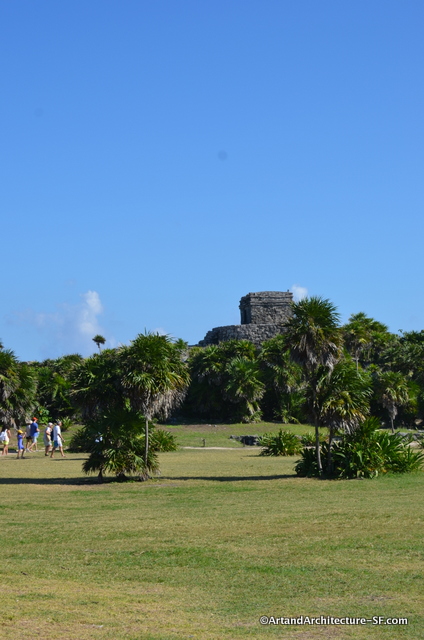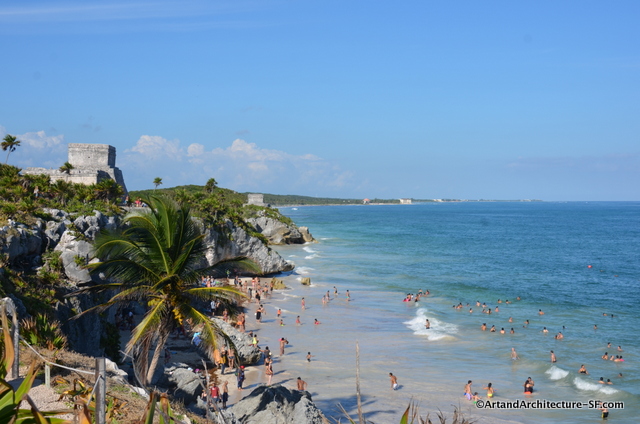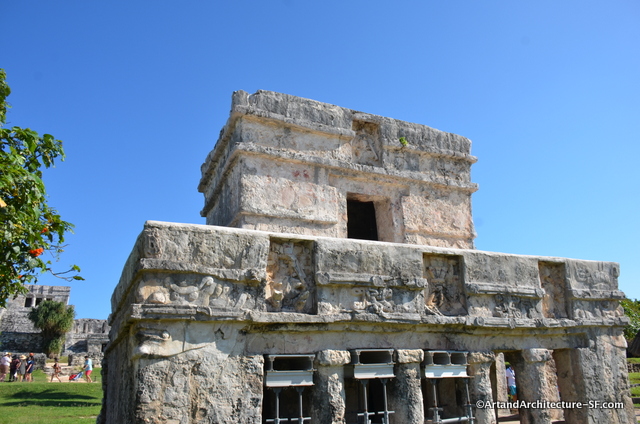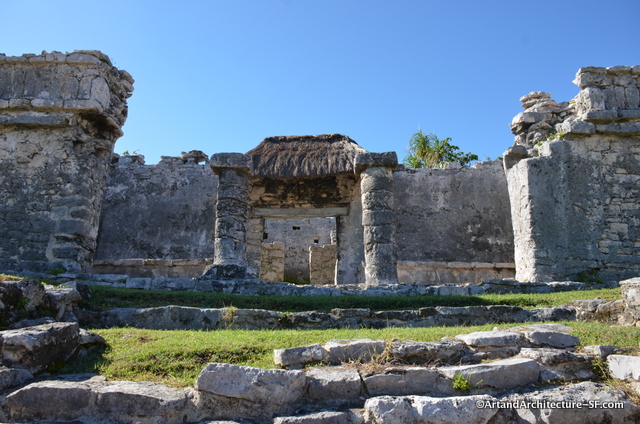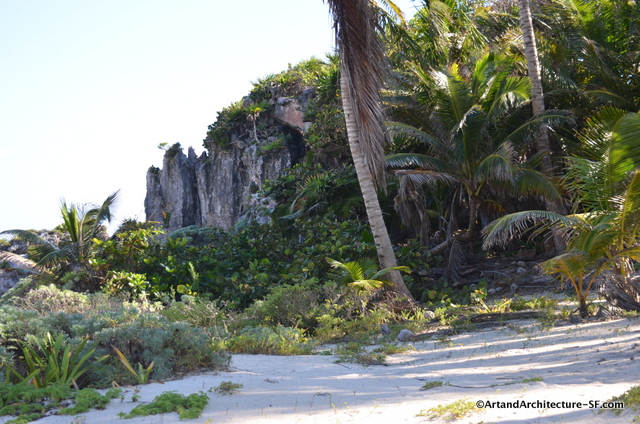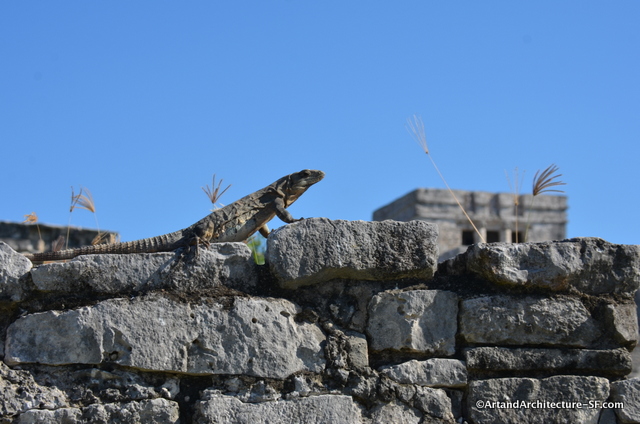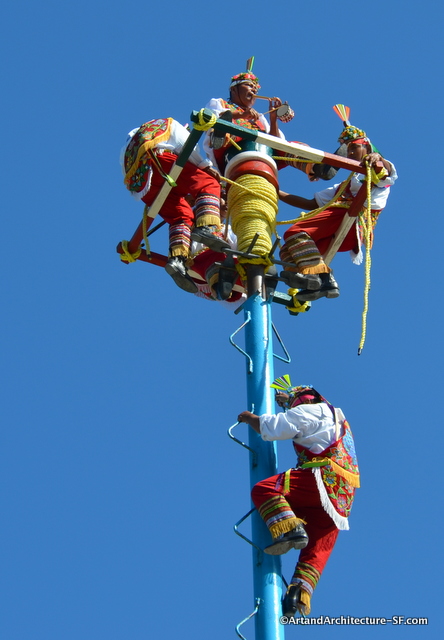The city of Tulum is not something to write home about. It, like Cancun and Playa del Carmen developed due to, and for, tourism, it does not, in any way, represent the architecture or spirit of Mexico.
However, at the edge of the city sits the great ruins of an ancient civilization, and they are worth a visit.
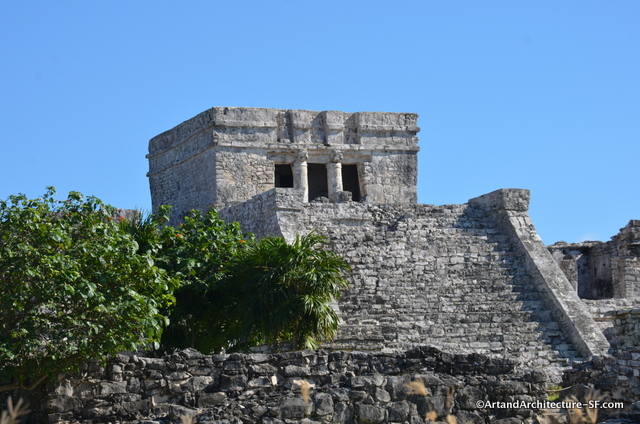
El Castillo got its name in 1518, by explorer J.L. Stephens since it looks like a castle from the distance. It is not know what many structures within Mayan settlements were used for, including El Castillo.
Tulum, a Mayan city, was a seaport, trading mainly in turquoise and jade. It is the only Mayan city built on a coast, and one of the few protected by a wall.
The wall, made of limestone, is 2572 feet long and encloses the site on three sides. It is twenty two feet thick, and varies from 9 to 15 feet tall. There can be little doubt that this fortification helped preserve the seaport.
The purpose for the wall is unclear. One theory is for protection from invaders, another is that only priests and nobility lived with in the walls while the peasants lived outside.
There have been five doorways cut into the wall, now secured with concrete for the tourists. Once you enter you get a feel for how big the fortification was.
It is not possible to climb any of the structures at Tulum, however you can get a stunning view of the Caribbean Sea from many advantage points.
In front of the Castillo is the Temple of the Frescoes. Inside there is a mural painted in three sections. The first represents the Mayan world of the dead, the middle is that of the living, and the final, the highest piece, is of the creator and rain gods.
One interesting fact, is that in the middle of the living section is a god astride a four-legged animal thought to be a horse. If it is a horse, that would mean that the Mayans still occupied Tulum in 1518 when they would have seen horses brought by the Spanish. There are also a figure chiseled above the doorway. It is presumed to be a Mayan god of protection.
Halach Uinic means “Real Man” and is one of the words the Mayans used to designate kings. The reason for the name is not because we are certain the usage of the building, but because of its size.
This stretch of the beach is off limits to people. It serves as a turtle nesting area from May to October.

and coatis. Coatis are a member of the raccoon family and are about 1-2 feet long with their tail being almost as long as their bodies. They have long snouts and their facial markings are similar to raccoons. They weigh between 6 and 18 lbs., about the same size as a domestic cat.
If you get down to the beach area, you will find many colorful boats bringing tourists to photograph the ruins from the water. The stairway down to the beach is a well kept secret. The easiest way to spot the stairs is to take the Archeology path which is near the south exit, or head to the Temple of the Birds and follow people in bathing suits carrying beach towels.
The entrance to the Tulum ruins is a swarm of tourist traps. There is even a Starbucks. The walk to the ruins takes about 10 minutes, but due to the humidity and heat many opt for the 20 peso train.
While you are waiting for the train you will be assaulted by quite a lot of people selling things.
A nice diversion while waiting are the flying men performing the Danza de Voladores. This traditional dance comes from Papantla in the state of Veracruz, Mexico.
It is believed to have originated with the Nahua, Huastec and Otomi peoples. The ritual begins with five people climbing a 100 foot pole and then, tied with ropes, they descend to the ground. The fifth person remains on top of the pole, dancing and playing a flute and drum. According to one myth, the ritual was created to ask the gods to end a severe drought. The ceremony was named an Intangible cultural heritage by UNESCO.
 At the Tulum ruins these gentlemen can be extremely aggressive in their request for money, and will get very argumentative if they do not think you have given enough. Just stand your ground, but be aware.
At the Tulum ruins these gentlemen can be extremely aggressive in their request for money, and will get very argumentative if they do not think you have given enough. Just stand your ground, but be aware.
Some hints about visiting. The trip from downtown Tulum should be no more than 70 to 100 pesos, however, when you return and approach the taxi stand be prepared for price gouging. If you don’t speak the language well you most likely will pay what asked, but if you can bargain you should.
The area is hot and humid, while you can buy water and soft drinks in the stores at the front, the prices will be twice what you pay in town, so I suggest you take a bottle of cold water with you.
It is very hot at the ruins and while there are often fabulous sea breezes, there are very few trees so a hat or umbrella is a good idea for those sensitive to the sun.
Tulum is very very humid, and mosquitos abound, as well as sand fleas and Tabanas. So cover yourself with bug spray, as well as sun screen, before embarking on your journey.
